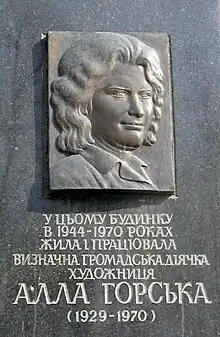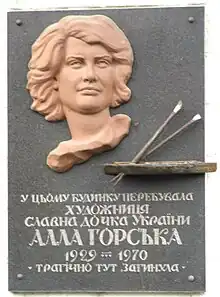Alla Horska
Alla Horska (Ukrainian: Алла Горська; 18 September 1929, Yalta — 17 November 1970, Vasylkiv) was a Ukrainian artist of the 1960s, monumentalist painter, one of the first representatives of the underground art movement, dissident, and human rights activist of the Sixtiers movement in Ukraine.
Alla Horska | |
|---|---|
| Алла Горська | |
 Memorial plaque on the house where Alla Horska lived | |
| Born | 18 September 1929 |
| Died | November 17, 1970 (aged 41) |
| Nationality | Ukrainian |
| Citizenship | Soviet Union |
| Alma mater | National Academy of Arts of Ukraine |
| Known for | art, painting, human rights activism |
| Movement | dissident movement in the Soviet Union |
Biography
In 1962 Alla Horska became one of the founders and active members of the Club of Creative Youth.[1]
In 1962 Alla Horska, Vasyl Symonenko and Les Tanyuk revealed the unmarked mass grave sites of those "enemies of the Soviet state" disposed by NKVD in Bykivnia, Lukyanivsky and Vasylkivsky cemeteries. The activists declared it to the Kyiv City Council ("Memorandum II").[2]
In 1965–1968 she took part in protests against the repressions of Ukrainian human rights activists: Bohdan and Mykhailo Horyn, Opanas Zalyvakha, Sviatoslav Karavansky, Valentyn Moroz, Vyacheslav Chornovil, and others. Because of this, she was persecuted by the Soviet security services. However, a kind of protection for her was that she, together with a group of artists, worked on monumental works of art in Donetsk and Krasnodon (now Sorokyne), which were considered important and had an ideological bias.

In 1967 Horska attended Viacheslav Chornovil’s trial in Lviv. There was a group of Kyiv activists who protested against the illegal conduct of court proceedings. The next year she signed Protest Letter 139 addressed to General Secretary of the Communist Party of the Soviet Union demanding to cease such illegal proceedings.[3] Consequently, the KGB began pressuring and threatening the signatories of this letter.[2]
Death
Alla Horska was murdered in 1970 while under surveillance by the KGB. Her funeral was on 7 December 1970. It became a civil resistance campaign in which such well-known dissidents as Yevgen Sverstiuk, Vasyl Stus, Ivan Gel, and Oles Serhienko made their speeches.[4]
Honoring the memory
See also
References
- "Horska, Alla". www.encyclopediaofukraine.com. Retrieved 30 June 2020.
- Chraibi, Christine (29 December 2015). "Dissident artist Alla Horska murdered 45 years ago". Euromaidan Press. Archived from the original on 29 December 2015. Retrieved 30 June 2020.
- "HORSKA, Alla Oleksandrivna – Ukrainian National Movement". Dissident movement in Ukraine. Retrieved 30 June 2020.
- Pecherska, Nataliia (2 May 2020). "Alla Horska. Die Hard". DailyArtMagazine.com – Art History Stories. Retrieved 30 June 2020.
- Kozyrieva, Tetiana (6 December 2017). "Alla HORSKA: the soul of Ukraine's 1960s movement". The Day. Archived from the original on 2 March 2021.